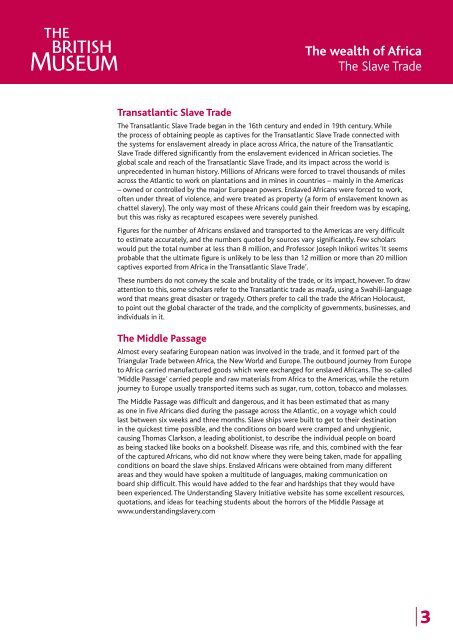The wealth of Africa The Slave Trade - British Museum
The wealth of Africa The Slave Trade - British Museum
The wealth of Africa The Slave Trade - British Museum
You also want an ePaper? Increase the reach of your titles
YUMPU automatically turns print PDFs into web optimized ePapers that Google loves.
Transatlantic <strong>Slave</strong> <strong>Trade</strong><br />
<strong>The</strong> <strong>wealth</strong> <strong>of</strong> <strong>Africa</strong><br />
<strong>The</strong> <strong>Slave</strong> <strong>Trade</strong><br />
<strong>The</strong> Transatlantic <strong>Slave</strong> <strong>Trade</strong> began in the 16th century and ended in 19th century. While<br />
the process <strong>of</strong> obtaining people as captives for the Transatlantic <strong>Slave</strong> <strong>Trade</strong> connected with<br />
the systems for enslavement already in place across <strong>Africa</strong>, the nature <strong>of</strong> the Transatlantic<br />
<strong>Slave</strong> <strong>Trade</strong> differed significantly from the enslavement evidenced in <strong>Africa</strong>n societies. <strong>The</strong><br />
global scale and reach <strong>of</strong> the Transatlantic <strong>Slave</strong> <strong>Trade</strong>, and its impact across the world is<br />
unprecedented in human history. Millions <strong>of</strong> <strong>Africa</strong>ns were forced to travel thousands <strong>of</strong> miles<br />
across the Atlantic to work on plantations and in mines in countries – mainly in the Americas<br />
– owned or controlled by the major European powers. Enslaved <strong>Africa</strong>ns were forced to work,<br />
<strong>of</strong>ten under threat <strong>of</strong> violence, and were treated as property (a form <strong>of</strong> enslavement known as<br />
chattel slavery). <strong>The</strong> only way most <strong>of</strong> these <strong>Africa</strong>ns could gain their freedom was by escaping,<br />
but this was risky as recaptured escapees were severely punished.<br />
Figures for the number <strong>of</strong> <strong>Africa</strong>ns enslaved and transported to the Americas are very difficult<br />
to estimate accurately, and the numbers quoted by sources vary significantly. Few scholars<br />
would put the total number at less than 8 million, and Pr<strong>of</strong>essor Joseph Inikori writes ‘It seems<br />
probable that the ultimate figure is unlikely to be less than 12 million or more than 20 million<br />
captives exported from <strong>Africa</strong> in the Transatlantic <strong>Slave</strong> <strong>Trade</strong>’.<br />
<strong>The</strong>se numbers do not convey the scale and brutality <strong>of</strong> the trade, or its impact, however. To draw<br />
attention to this, some scholars refer to the Transatlantic trade as maafa, using a Swahili-language<br />
word that means great disaster or tragedy. Others prefer to call the trade the <strong>Africa</strong>n Holocaust,<br />
to point out the global character <strong>of</strong> the trade, and the complicity <strong>of</strong> governments, businesses, and<br />
individuals in it.<br />
<strong>The</strong> Middle Passage<br />
Almost every seafaring European nation was involved in the trade, and it formed part <strong>of</strong> the<br />
Triangular <strong>Trade</strong> between <strong>Africa</strong>, the New World and Europe. <strong>The</strong> outbound journey from Europe<br />
to <strong>Africa</strong> carried manufactured goods which were exchanged for enslaved <strong>Africa</strong>ns. <strong>The</strong> so-called<br />
‘Middle Passage’ carried people and raw materials from <strong>Africa</strong> to the Americas, while the return<br />
journey to Europe usually transported items such as sugar, rum, cotton, tobacco and molasses.<br />
<strong>The</strong> Middle Passage was difficult and dangerous, and it has been estimated that as many<br />
as one in five <strong>Africa</strong>ns died during the passage across the Atlantic, on a voyage which could<br />
last between six weeks and three months. <strong>Slave</strong> ships were built to get to their destination<br />
in the quickest time possible, and the conditions on board were cramped and unhygienic,<br />
causing Thomas Clarkson, a leading abolitionist, to describe the individual people on board<br />
as being stacked like books on a bookshelf. Disease was rife, and this, combined with the fear<br />
<strong>of</strong> the captured <strong>Africa</strong>ns, who did not know where they were being taken, made for appalling<br />
conditions on board the slave ships. Enslaved <strong>Africa</strong>ns were obtained from many different<br />
areas and they would have spoken a multitude <strong>of</strong> languages, making communication on<br />
board ship difficult. This would have added to the fear and hardships that they would have<br />
been experienced. <strong>The</strong> Understanding <strong>Slave</strong>ry Initiative website has some excellent resources,<br />
quotations, and ideas for teaching students about the horrors <strong>of</strong> the Middle Passage at<br />
www.understandingslavery.com<br />
3

















